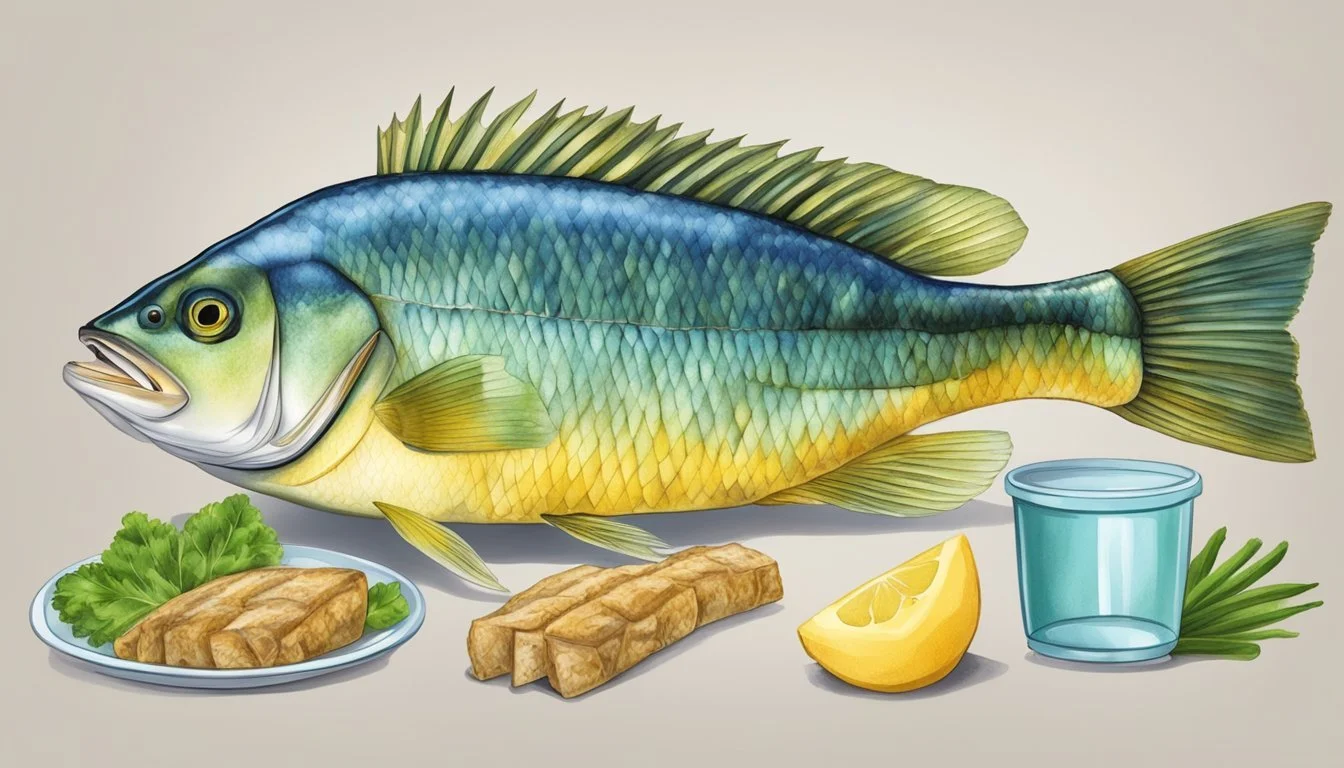Can Diabetics Eat Wrasse?
Understanding Dietary Choices
For individuals managing diabetes, making informed dietary choices is crucial to maintaining stable blood sugar levels. Many are curious about whether they can incorporate various types of seafood, such as Wrasse, into their diet. Yes, diabetics can eat Wrasse, as it is a nutritious fish that can be part of a healthy diet.
Wrasse is rich in protein and low in carbohydrates, which is beneficial for controlling blood sugar levels. The fish also provides essential nutrients like omega-3 fatty acids and vitamins, contributing to overall health. Including Wrasse in one's diet can offer a delicious and nutritious option without causing significant spikes in blood sugar.
It's important for diabetics to balance their meals and monitor their blood glucose levels regularly. Pairing Wrasse with non-starchy vegetables and whole grains can create a balanced, diabetes-friendly meal. This approach helps in maintaining a healthy diet while enjoying a variety of flavors.
Understanding Diabetes and Dietary Needs
Managing diabetes requires careful attention to dietary choices to maintain stable blood sugar levels and overall health. Key areas include what foods to eat, how to balance macronutrients, and the role of specific nutrients in diabetes management.
Role of Diet in Managing Diabetes
Diet plays a crucial role in managing diabetes. Eating the right foods helps control blood glucose levels. Non-starchy vegetables, healthy fats, and lean proteins should be prioritized. Limiting carbohydrates can reduce blood sugar spikes, important for both type 1 and type 2 diabetes.
Including fiber in meals can slow glucose absorption. Foods high in fiber, like whole grains and vegetables, help maintain steady blood sugar. Protein and healthy fats also support balanced glucose levels, providing energy without causing rapid spikes.
A personalized eating plan based on individual needs and preferences can significantly improve diabetes management.
Balancing Macronutrients for Blood Sugar Control
Balancing carbohydrates, protein, and fat is essential. Carbohydrates directly affect blood sugar; hence, quality and quantity must be monitored. Carbs should come from whole, unprocessed sources like vegetables, whole grains, and legumes, as they have a lower glycemic index.
Protein, including lean meats, fish, and plant-based sources, helps maintain muscle and repair tissues. It also aids in steadying blood sugar by slowing carbohydrate absorption.
Healthy fats, such as those from avocados, nuts, and olive oil, should replace saturated and trans fats. These support heart health, which is crucial for diabetics who are at a higher risk for cardiovascular diseases. Balancing these macronutrients helps keep blood sugar in check and supports overall health.
Nutritional Profile of Wrasse
Wrasse fish offer a notable source of protein and are rich in essential vitamins and minerals. This section emphasizes the key nutritional aspects that make wrasse a valuable addition to a well-rounded diet, especially for individuals with dietary concerns like diabetes.
Wrasse as a Protein Source
Wrasse fish are packed with high-quality protein, which is crucial for maintaining muscle mass and supporting overall health. A 100-gram serving of wrasse can provide around 20 grams of protein. This makes it a robust option for those looking to increase their protein intake without consuming excessive fats or calories.
Additionally, the protein found in wrasse is complete, meaning it contains all essential amino acids. These amino acids are necessary for various bodily functions, including tissue repair and enzyme production, which are particularly important for individuals managing diabetes.
Vitamins and Minerals in Wrasse
Wrasse fish are also abundant in essential vitamins and minerals. They are a good source of vitamins A, D, and B12, which play significant roles in vision, bone health, and energy production. Adequate levels of these vitamins are vital for maintaining overall wellness.
Moreover, wrasse contains minerals like calcium, magnesium, and phosphorus. These minerals contribute to bone strength, nerve function, and metabolic processes. Of particular note is the presence of omega-3 fatty acids in wrasse. Omega-3s are known for their anti-inflammatory properties and benefits to heart health, which can be especially beneficial for those managing diabetes-related complications.
Including wrasse in the diet can thus offer a robust nutritional profile that supports various aspects of health.
Wrasse in a Balanced Diabetic Diet
Wrasse is a nutritious fish with potential benefits for individuals managing diabetes, offering lean protein and healthy fats. It can be compared to other protein sources and incorporated into various meal plans tailored for those with type 2 diabetes.
Comparing Wrasse to Other Protein Sources
Wrasse is a lean protein, similar to chicken and turkey without the skin. It contains healthy fats, such as omega-3 fatty acids, which are good for heart health. Compared to red meats like beef, which are higher in saturated fats, wrasse is a healthier option, particularly for individuals with type 2 diabetes.
Calorie-wise, wrasse is lower than many fatty fish, making it a suitable addition to a low-calorie diet. For those trying to maintain blood sugar levels, wrasse offers high-quality protein without the added risk of insulin spikes that can accompany higher-fat meats.
Incorporating Wrasse into Diabetic Meal Planning
Dietitians often recommend including a variety of protein sources, and wrasse can be a tasty and nutritious option. To incorporate wrasse into a diabetic meal plan, consider grilling or baking rather than frying to keep the calorie content low and preserve the healthy fats.
Meal planning ideas include:
Lunch: A wrasse salad with non-starchy vegetables.
Dinner: Grilled wrasse alongside a serving of whole grains and steamed vegetables.
These meal options help balance blood sugar levels while providing heart-healthy fats and essential nutrients. Additionally, portion control is key; aim for a serving size of about 3-4 ounces to ensure you are receiving adequate protein without excessive calories.
Potential Health Benefits of Wrasse
Wrasse fish can be a nutritious addition to a diabetic's diet, offering potential benefits for heart health, blood pressure, and possibly blood sugar regulation. With a rich nutrient profile, including omega-3 fatty acids and antioxidants, wrasse can serve in various health-supportive roles.
Heart Health and Blood Pressure
Wrasse fish are rich in omega-3 fatty acids, which are essential for maintaining cardiovascular health. These compounds help reduce triglyceride levels, lower blood pressure, and decrease the risk of heart disease.
Eating wrasse can also contribute antioxidants, which combat oxidative stress, a factor that negatively impacts heart health.
Incorporating these fish into a balanced diet can provide these beneficial nutrients and improve overall cardiovascular wellness, which is critical for individuals with diabetes.
Anti-inflammatory Properties
Including wrasse in meals can offer significant anti-inflammatory benefits due to its omega-3 fatty acids content, which helps reduce inflammation in the body. Chronic inflammation is associated with various diseases, including diabetes.
These fatty acids help reduce the production of inflammatory markers, thereby promoting a healthier immune response.
By alleviating inflammation, wrasse can potentially ease the symptoms of inflammatory conditions, making it a valuable addition for those managing diabetes-related complications.
Impact on Blood Sugar and Insulin Sensitivity
While direct research on wrasse's impact on blood sugar levels is limited, the fish's nutrient components can indirectly support glucose management. The omega-3 fatty acids in wrasse have been linked to improved insulin sensitivity, which helps the body manage blood sugar levels more effectively.
Additionally, lean protein from fish can moderate post-meal glucose spikes, aiding in better blood sugar control.
Including wrasse in a diabetic diet may help stabilize insulin levels and reduce the risk of blood sugar fluctuations, providing a degree of dietary support for diabetes management.
Safety and Consumption Guidelines
Eating wrasse, particularly for diabetics, involves understanding portion sizes and potential health risks. Specific intake recommendations and knowledge of seafood-related hazards are crucial.
Recommended Intake for Diabetics
Diabetics should consult with a dietitian before incorporating wrasse into their meal plans. Wrasse, like most seafood, is rich in protein but also contains cholesterol. Monitoring cholesterol levels is vital, as excessive intake can negatively impact heart health.
A balanced serving size for wrasse might be around 3-4 ounces, ensuring it fits within the daily protein allowance. Wrasse is low in carbohydrates, making it a suitable option for diabetics aiming to control blood glucose levels.
When planning meals, diabetics should also consider the sodium content in seafood. Excessive sodium can affect blood pressure, which is often a concern for diabetic patients. Limiting wrasse intake to a few times a week can help manage these nutrient levels effectively. Aim to pair wrasse with non-starchy vegetables to create a balanced meal.
Understanding Seafood Consumption Risks
While seafood, including wrasse, can be beneficial, potential risks exist. Mercury and other contaminants are a concern. Diabetics should be aware that large predatory fish tend to have higher mercury levels, although wrasse is typically lower in the food chain.
Always ensure that the wrasse consumed is sourced from clean waters to minimize exposure to pollutants. Cooking methods also play a role in safety. Grilling, baking, or steaming wrasse can help maintain its nutritional benefits without adding extra fats or sodium.
Pay attention to any allergic reactions to seafood. If new to eating wrasse, start with small portions and monitor for any adverse effects. Regularly reviewing dietary choices with a healthcare provider ensures both safety and nutritional balance.
Culinary Uses and Preparation Tips
Wrasse can be a nutritious addition to a diabetic-friendly diet due to its lean protein content and beneficial omega-3 fatty acids. Proper preparation and cooking methods are crucial to ensure it remains healthy and flavorful.
Healthy Cooking Methods for Wrasse
Using healthy cooking methods helps maintain the nutritional benefits of Wrasse. Baking, grilling, and steaming are preferred as they do not require excessive use of unhealthy fats.
For instance, baking Wrasse can be done by preheating the oven to 350°F, placing the fish in a baking dish, and lightly drizzling with olive oil. This method ensures the fish stays moist while adding healthy fats.
Grilling Wrasse is another great option. The grill should be preheated to medium heat. Wrasse fillets can be seasoned with herbs like rosemary or thyme and placed directly on the grill, ensuring a nice charred flavor while avoiding extra oils.
Steaming Wrasse preserves the fish's natural flavors and nutrients. Using a steamer, prepare the fish with a light seasoning of salt and herbs, and steam for about 10-15 minutes until fully cooked.
Flavor Pairings and Recipe Ideas
Wrasse pairs well with a range of flavors, enhancing its relatively mild taste. Fresh herbs like dill, parsley, and basil work very well. A simple recipe for grilled Wrasse can include lemon juice, olive oil, garlic, and a sprinkle of fresh herbs.
For a baked Wrasse dish, consider seasoning the fish with olive oil, minced garlic, chopped fresh herbs, and a touch of lemon zest. Bake it with a side of unprocessed vegetables like asparagus or bell peppers for a nutritious meal.
Steamed Wrasse can be beautifully complemented with a light sauce made from olive oil, chopped capers, and fresh lemon juice. This adds a Mediterranean flair, making the meal both healthy and delicious.
Additionally, integrating Wrasse into salads, with ingredients like mixed greens, cherry tomatoes, and a light vinaigrette, can make for a refreshing and healthy dish suitable for diabetics.
Substitutes and Alternatives
Diabetics looking for alternatives to Wrasse have several other seafood and plant-based options that can fit well into their diet. These options include various types of fish known for their nutritional benefits, as well as plant-based alternatives that can provide essential proteins and nutrients.
Other Fish and Seafood Options
For diabetics, fish like salmon, sardines, and mackerel are excellent alternatives to Wrasse.
Salmon is rich in omega-3 fatty acids, which help reduce inflammation and support heart health. It also provides a high amount of protein with minimal impact on blood sugar levels.
Sardines are another good choice because they are packed with calcium, vitamin D, and omega-3 fatty acids.
Mackerel offers similar benefits, with high levels of healthy fats and essential nutrients. It is also easier to find in many local markets.
These fish are not only nutritious but also versatile in cooking, making them convenient options for those who need to manage their blood sugar levels.
Plant-Based Alternatives
For those looking for plant-based substitutes, tofu, legumes, and nuts offer substantial nutritional benefits.
Tofu is a complete protein and can be used in a variety of dishes, making it a versatile option. It is also low in carbohydrates, which is beneficial for blood glucose control.
Legumes like lentils, chickpeas, and black beans are rich in fiber, which helps in maintaining steady blood sugar levels. They also contain significant amounts of protein and can be used in soups, salads, and stews.
Nuts and seeds provide healthy fats, protein, and fiber. Options such as almonds, walnuts, and chia seeds can be added to meals or eaten as snacks to help manage hunger and maintain energy levels.
These plant-based alternatives are not only healthy but also adaptable to various dietary preferences and restrictions.
Conclusion
When considering wrasse for diabetics, several factors must be examined.
Wrasse is a fish that is rich in protein and can be a healthy addition to a diabetic diet. Protein is essential for managing blood glucose levels as it has little impact on blood sugar.
However, not all wrasse species are safe to consume. It's important to identify whether the particular species of wrasse is edible before including it in the diet.
Eating wrasse could also aid in weight loss, another important aspect of managing diabetes. A high-protein diet can increase satiety, helping to reduce overall calorie intake.
Additionally, including wrasse as part of a balanced and varied diet can help improve insulin resistance. Fish, in general, is considered a good source of lean protein.
It's crucial for diabetics to avoid fried or heavily processed preparations of wrasse. These can introduce unnecessary fats and calories, potentially exacerbating obesity issues.
In summary, diabetics can eat wrasse, but they should ensure that the kind they are consuming is safe and they should choose healthy cooking methods. Moderation and balance are key components of any healthy diet for diabetes management.










